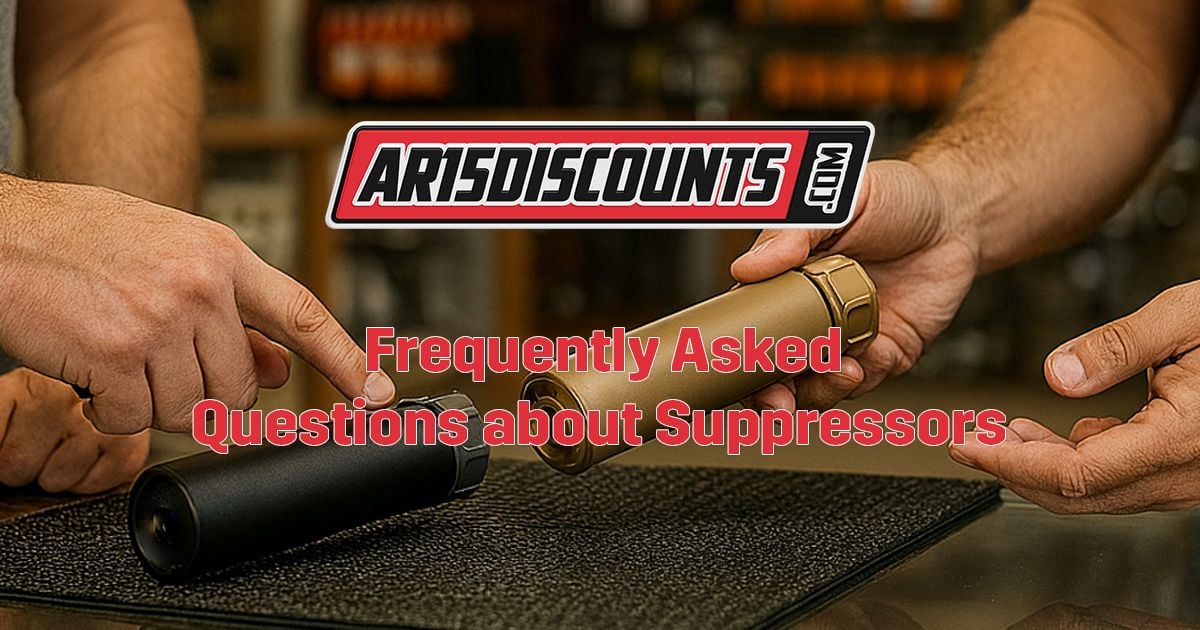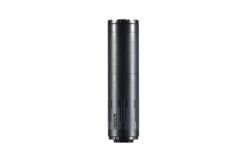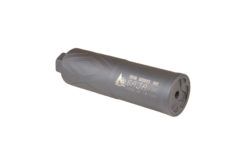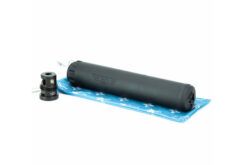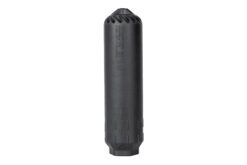NFA
Frequently Asked Questions about Suppressors
If you’re considering adding a suppressor to your firearm setup, you probably have a lot of questions — and for good reason. From legal requirements and ATF approval timelines to choosing the right suppressor for your caliber, there’s a lot to navigate. This comprehensive FAQ is designed to help you understand the ins and outs of suppressor ownership, so you can make informed decisions and shop with confidence. Whether you’re a first-time buyer or expanding your NFA collection, these answers cover the most common concerns we hear from customers at AR15Discounts.com.
To legally purchase a suppressor, you must be 21 years old, reside in a state where suppressors are legal, and follow the National Firearms Act process. Start by selecting the suppressor you want from a reputable dealer, such as AR15Discounts.com. We partner with licensed NFA dealers and manufacturers to streamline your purchase. You’ll need to complete ATF Form 4, submit fingerprints, a passport photo, and pay the $200 tax stamp. You can apply as an individual, a trust, or a corporation. Once your application is submitted, the waiting period typically begins, you can get more information on the waiting period here. When approved, your dealer will notify you, and you can take possession of your suppressor. Throughout the process, your dealer can assist you with paperwork, answer any questions, and ensure compliance. It’s a one-time process for each suppressor and is worth the wait for quieter, safer, and more effective shooting.
There is no functional difference between a suppressor and a silencer. The term “silencer” was coined by Hiram Maxim, the inventor of the device, but “suppressor” is the more accurate modern term. It reflects what the device does: suppress or reduce the sound signature of a firearm rather than eliminate it. Suppressors also reduce muzzle flash and recoil, making shooting more comfortable and improving accuracy in some cases. While both terms are used interchangeably in conversation and by the ATF, many in the firearms community prefer “suppressor” for its technical precision. Whether you’re shopping for a suppressor for your 9mm, .300 Blackout, or rimfire platform, the key is understanding that these terms refer to the same legal item, and both require NFA paperwork for civilian ownership.
Yes, suppressors are legal to own in most of the United States — currently, 42 states allow civilian ownership. They are regulated under the National Firearms Act (NFA), which requires a formal process that includes submitting fingerprints, a photograph, an ATF Form 4, and paying a $200 tax stamp. Once approved, you may own and use the suppressor legally, as long as you follow federal and local regulations. It’s essential to verify that your state allows suppressors, as some, such as California, Hawaii, New York, and Illinois, prohibit them. Suppressors can be used for hunting, range shooting, and self-defense in many jurisdictions. Always consult your local laws or a licensed dealer before making a purchase. At AR15Discounts.com, we work with reputable manufacturers and NFA dealers to simplify this process for our customers.
No, you do not need a special license to purchase a suppressor; however, you must complete the federal registration process under the National Firearms Act. This involves submitting an ATF Form 4 (Application for Tax Paid Transfer and Registration of Firearm), providing fingerprint cards and a recent passport-style photo, and paying the $200 tax stamp fee. This process is required whether you’re purchasing individually or as part of a trust. Once approved, you can legally possess and use the suppressor. You do not need a Federal Firearms License (FFL) or be in law enforcement to own one, as long as suppressors are legal in your state and you meet all federal requirements. At AR15Discounts.com, we collaborate with manufacturers and licensed NFA dealers to ensure that suppressor ownership is as smooth and compliant as possible.
A tax stamp is a federal document issued by the Bureau of Alcohol, Tobacco, Firearms, and Explosives (ATF) that proves you have paid the $200 tax required under the National Firearms Act to possess a regulated item such as a suppressor. The tax stamp is tied to your ATF Form 4 application and includes information such as your name, the serial number of the suppressor, and the date of approval. Once approved, the tax stamp must remain with the suppressor for its lifetime, unless it is transferred legally. While $200 may seem like a steep one-time fee, the tax stamp grants you permanent ownership of the suppressor and opens the door to quieter, more controlled shooting. At AR15Discounts.com, we offer a wide selection of suppressors for various calibers, helping customers navigate this essential step toward responsible ownership.
The time frame can vary depending on whether you file through paper forms or eForms, the volume of applications the ATF is processing, and whether you file as an individual or a trust. While the wait may seem long, recent updates to the eForms system have made electronic submissions faster and more convenient. Once approved, you’ll receive your tax stamp and can legally take possession of your suppressor. Many manufacturers and dealers — including those we partner with at AR15Discounts.com — offer tracking support and submission guidance to help reduce errors and improve turnaround time. We recommend starting the process early if you plan to have a suppressor ready for hunting season, competition, or range use. You can more information here on ATF’s offical website.
Yes, many suppressors are designed to be multi-caliber, meaning you can use them across different firearms and calibers, provided the suppressor is rated for the cartridge you’re firing. For example, a .30-caliber suppressor can typically handle .308 Winchester, 300 BLK, and even smaller calibers, such as 5.56 NATO or 6.5 Grendel. Some 9mm suppressors are also capable of shooting .300 BLK subsonic rounds, depending on the design. However, it’s critical to match the suppressor to the firearm’s pressure and thread pattern. Using a suppressor outside of its rated caliber or without proper concentricity can lead to dangerous baffle strikes. Always consult the manufacturer’s guidelines. Brands like Q, Rugged, and AB Suppressors offer modular systems and thread adapters to facilitate easier caliber switching. If in doubt, use a suppressor alignment rod to double-check fitment across hosts.
Suppressors offer a range of benefits that enhance both the shooting experience and the performance of firearms. First and foremost, they reduce the sound signature of a gunshot, protecting your hearing and making range sessions more enjoyable. This noise reduction also minimizes noise pollution for nearby communities and helps in hunting scenarios by avoiding scaring off game. Suppressors reduce recoil and muzzle rise, improving follow-up shot accuracy and control, especially useful in rapid-fire or defensive situations. They also suppress muzzle flash, which is a tactical advantage in low-light conditions. Additionally, suppressors contribute to a cleaner shooting environment by containing gas blowback and carbon. Whether you’re shooting a 9mm pistol, .300 Blackout AR-15, or a rimfire plinker, the benefits of adding a suppressor are clear, and the investment pays off in both performance and protection.
No, suppressors are not silent — that’s a typical Hollywood myth. Instead, suppressors significantly reduce the noise generated when a firearm is discharged by slowing and cooling expanding gases that follow the bullet. For example, an unsuppressed 9mm pistol can produce sound levels of 160 dB or more, while a suppressed one may reduce that to 125–135 dB, which is still loud but much safer for hearing. Using subsonic ammunition further reduces the sound because it avoids the loud “crack” of a bullet breaking the sound barrier. While suppressors make shooting more comfortable and less harmful to your ears, hearing protection is still recommended in most cases. The key benefit isn’t total silence — it’s a substantial reduction in report, recoil, and muzzle flash, making suppressed firearms more practical and enjoyable across various platforms.
Suppressors work by capturing and slowing the expanding gases that exit the barrel when a firearm is discharged. Internally, suppressors feature a series of baffles or expansion chambers that dissipate pressure, redirect gas flow, and allow the gases to cool before exiting the muzzle. This process significantly reduces sound, flash, and felt recoil. Some suppressors are sealed and maintenance-free, while others are user-serviceable, featuring removable baffles for easy cleaning. Suppressors are especially effective when paired with subsonic ammunition, which avoids the sonic boom associated with supersonic projectiles. Materials like stainless steel, titanium, and Inconel are commonly used in suppressors to withstand high heat and pressure. Modern suppressors from brands like SureFire, B&T, and Q Suppressors utilize advanced engineering and metallurgy to deliver optimal performance across various platforms, including rifles, pistols, and rimfire firearms.
The best materials for suppressors depend on the intended use, caliber, and budget. Titanium is lightweight, corrosion-resistant, and strong, making it an ideal material for high-performance rifle suppressors where weight is a critical factor. Stainless steel is commonly used in pistol and rifle suppressors due to its durability and affordability — it handles high heat well and is easy to machine. Inconel, a superalloy, offers superior heat resistance and strength for sustained full-auto fire or extremely high-pressure loads. Aluminum is lightweight and affordable, but it is primarily used in rimfire suppressors because it lacks the heat tolerance of steel or titanium. Most modern suppressors utilize a combination of materials to strike a balance between weight, strength, and cost. At AR15Discounts.com, you’ll find suppressors from leading brands like AAC, Rugged, and Thunderbeast, each offering specific models optimized for material performance.
Suppressor maintenance depends on the type of suppressor and the type of ammunition used. Rimfire suppressors, especially those for .22LR models, require regular cleaning due to the dirty, unjacketed rounds that leave behind lead and carbon fouling. These should be disassembled and scrubbed with a solvent and brush every few hundred rounds. Centerfire rifle suppressors generally require less frequent cleaning — many are sealed and designed to self-clean through heat and pressure. However, occasional carbon burn-offs or ultrasonic cleaning can extend life. For modular suppressors like the Obsidian 9 or CAT suppressors, disassembly is simple and user-friendly. Always consult the manufacturer’s guidelines for proper care and maintenance. Avoid using harsh abrasives or wire wheels, as they can damage the baffles. A clean suppressor runs cooler, quieter, and more consistently. At AR15Discounts.com, we carry cleaning tools and accessories to help you keep yours in top shape.
If a suppressor is damaged — whether from a baffle strike, corrosion, or impact — it must be repaired by the original manufacturer or a licensed NFA gunsmith. You should never attempt to fix it yourself, as this may violate federal law and damage the serialized components. If the suppressor can’t be repaired, it can sometimes be replaced under warranty, depending on the brand. Some companies, like Rugged and Q, offer lifetime guarantees or repair programs. Because suppressors are serialized NFA items, replacements or recores must be handled through proper ATF procedures. It’s always a good idea to store your suppressor in a protective case and avoid improper mounting practices, which are common causes of damage. At AR15Discounts.com, we exclusively carry suppressors from reputable manufacturers that offer strong customer service and comprehensive warranty support.
Suppressors themselves cannot be carried concealed unless attached to a legally carried concealed firearm, and even then, the legality depends on your local laws. Most states do not permit the concealed carry of a gun with a suppressor due to issues related to length, visibility, and classification. Additionally, some jurisdictions may treat the presence of a suppressor as a violation of carry restrictions. If you plan to carry a suppressed pistol — such as a Glock suppressor-ready model or the P-10 C suppressor-ready Urban Gray — be sure to review your state’s concealed carry laws. In practice, suppressors are more commonly used in home defense or open-range shooting scenarios rather than everyday carry. When in doubt, consult a local firearms attorney or your state’s department of justice. Suppressors are a serious responsibility, and legal compliance is key.
Final Thoughts on Suppressor Ownership
Suppressors are one of the most practical upgrades you can make to your firearm, offering better control, reduced noise, and increased shooting comfort. But like any regulated item, they come with unique considerations — from legal compliance to maintenance and caliber compatibility. By understanding the answers to these frequently asked questions, you’re already one step closer to becoming a responsible, well-informed suppressor owner. If you’re ready to start the process or want to explore our top-rated models, visit AR15Discounts.com — where performance meets compliance.

